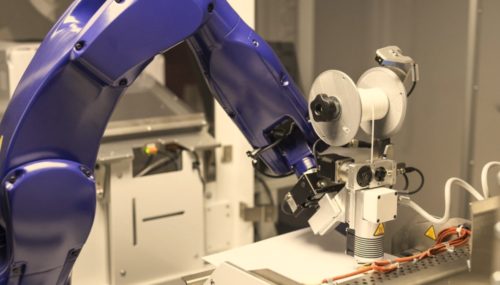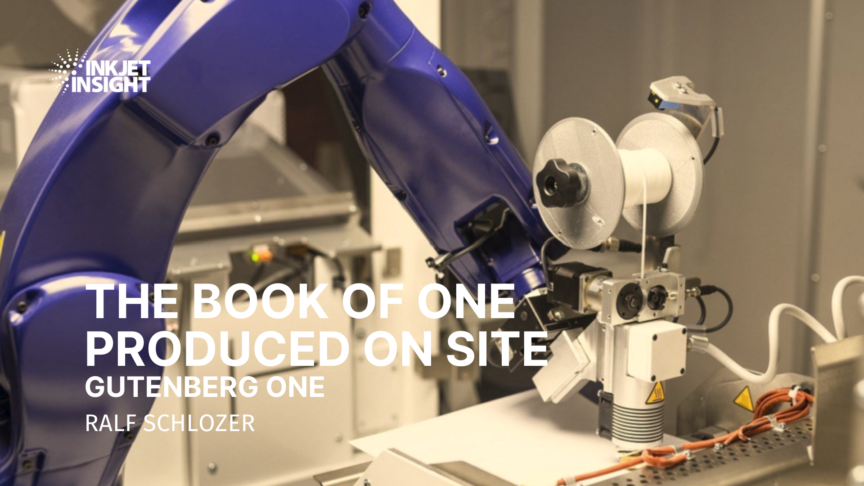Entering a location, maybe a book shop, and having the book you want printed and bound within a few minutes, this is the promise of Gutenberg One. The Gutenberg One is a compact and fully self-contained printing and binding unit for books, which is small and affordable enough to be placed in a wide range of locations
If the idea sounds somehow familiar, you might have heard from predecessor projects like the Xerox Espresso Book machine. So far, these book-on-demand on site printers had a very limited impact on the market. France-based Gutenberg & Co (www.gutenbergandco.com – so far only in French) promises to change this with the Gutenberg One. To fit in a limited retail space, the Gutenberg One has a footprint of about 4 m² (43 ft²) and is able to produce a book in under 5 mins.
Gutenberg & Co was founded in 2019 by Hubert Pedurand, who is now president of the company. Gutenberg & Co has several partner companies in the field of robotics, print and software that support the development.
The technology
To produce a complete book on site the device needs to combine a front-end, a printer for book block and cover as well as options for binding and trimming.
In the Gutenberg One the printing unit is based on a RISO inkjet printer. The printer produces 120 monochrome or colour A4 pages per minute. Printing 2-up effectively doubles the output speed. Full colour covers are produced on an OKI LED toner printer, as the colour quality of the RISO printer is somewhat limited. Although most books are likely to require monochrome print only, colour is an inherent option and can be helpful for example for educational textbooks. RISO’s oil-based inkjet technology does not require active drying, which helps in keeping the device compact.
The innovation in the Gutenberg One is a robotic arm that can take the book block from stage to stage, apply the glue, place it in the trimmer and finally into the delivery. Even at first sight this is a huge improvement on the belts and levers used before.
The patent of Hubert Pedurand is in a 3D glue gun. The operation can be best viewed in a video, but in short: the robotic arm can grab a glue gun to apply the required amount of glue to the spine. This avoids having an open reservoir of glue which can deteriorate over time or needs considerable time to heat up.

Applying the glue with a glue gun
The robotic arm also feeds the cover into a creasing unit, places the book block on the applied glue, feeds the trimmer and finally places the book in the delivery. An interesting aspect is that the arm can grab and rotate the book block multiple times, therefore only a single knife trimmer is needed.
There are some format limitations set by the hardware but they give a fairly wide range. Book sizes from 100 x 150 mm (4” x 6”) as smallest to 200 x 280 mm (7.9” x 11”) as largest format are possible. Page counts can range from 32 to 800 pages.
In the first presentations a touchscreen panel was used as user interface for the Gutenberg One. This is going to be replaced by a browser-based interface that can be operated by hand-held devices or PCs.
All the titles
Theoretically an unlimited amount of books is accessible with an internet connection and access to libraries of publishers and rights owners.
In practice the rights situation requires negotiations with publishers. Gutenberg & Co made good progress in France with enlisting major publishers and having about 45,000 titles in the catalogue already. In other countries the start-up nature creates a chicken-and-egg problem. Publishers are likely to grant print rights with a fleet of devices installed, but without enough books in access there is little incentive to install a machine. The business case for publishers would be easy, especially for back catalogue titles: publishers would get a 22% royalty of the face price for every book printed and sold (based on the agreement with French publishers).
Gutenberg One installations in public places such as book-shops would require a large selection of titles. There are locations where this could be less required: A university could set up a device to print textbooks, thesis and research reports. An organisation could print their self-published literature or a publisher use it as on-demand reprint station.
The Use Case of Gutenberg One
The ever increasing number of books, including self-published titles, result in a mushrooming backlist of books. Even for actual titles, publishers are trying to reduce stock keeping to lower their risk. This all leads to even shorter runs and more on-demand production.
Not all books can or should be produced on a Gutenberg One. With about 10 books per hour production capacity (and the double as 2-up in A5 format), runs of more than a few copies are better produced on a centralised print-on-demand line. Also centralised book-of-one printing concepts (Amazon, BoD in Germany) capable of delivering books overnight to a bookshop or to the home of the reader pose some competition. Yet there is some convenience in having the book produced right away.
Obviously, there are technical limitations in colour quality, size, page count as well, which would exclude certain types of books. However, with the specifications as planned most published books can be produced on the Gutenberg One.
The business model for the owner is simple. The breakdown of the cost of a book is as follows:
- Production cost (including the investment) 55%
- Publisher & Author: 22%
- Gutenberg & Co royalties: 17.5%
- VAT (for France): 5%
This is based on a machine cost of €120.000 and a production cost of 1 cent/page plus a small fixed cost depending of the volume produced locally.
The Gutenberg One could be a great solution for remote locations or developing countries. Where the traditional model of centralised book printing and distribution is falling short for some reason a local production unit can help readers.
Another opportunity would be bringing the Gutenberg One in environments where consumers shop and browse and don’t mind waiting for 5 minutes, e.g. shopping arcades, stylish cafes. Universities, libraries or transport hubs could be good locations as well.
Rolling out the solution
Despite the lack of adoption of previous device generations, Hubert is confident to have the right mix now. He bought six Espresso Book machines for his R&D with 5 installed in schools and one in a book shop, all in France. This gave him opportunity to study the concept and technology. He points out that the patents of the Espresso book machine were filed back in 1993, while the Gutenberg is able to benefit from all kind of technological progress so far.
The first machine is in production since November 2021 at l’Harmattan, a publisher-bookstore in Paris with 38.000 titles available on the Gutenberg One. A second device is being installed at a publisher in the North of France needing an instant reprint capacity for runs of one to balance out current supply chain interruptions. This installation is planned to run in a 2-shift operation to produce 50,000 to 60,000 books in the run length of one per year, with a 68% lower carbon footprint compared to traditional production.
While in discussions with prospects for a Gutenberg One, Gutenberg & Co is looking for investors to scale the roll-out and ideally set-up a network of devices. A wider roll-out could kick-off a Domino effect as more devices installed will get more titles listed and this would improve the attractiveness.
For the future success a lot will depend on the access to a wide range of titles that would be required e.g. in bookshops, although a print kiosk in certain locations could focus on a narrow range of titles too. Important is as well how easy the Gutenberg One is to service and how good the reliability of the overall system is. Test installations will need to show this. In any case, the Gutenberg One is a solution to increase the potential audience of printed books around the world. And as studies show, reading printed books improves the grades of pupils, improves the understanding of texts and increases the enjoyment in reading in general. I fully concur to the latter.
Investors contact: Hubert PEDURAND, hubert@neomedias.com / +33 647304784


Comments
This is a fascinating project and while I have my doubts, I would love to see it succeed!
Well I would rather have a kiosk for a book than a bicycle – so let’s hope we see this roll out like the bikes have.